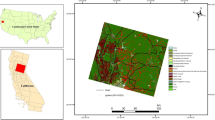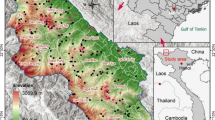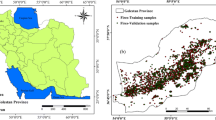Abstract
A constant and controlled level of emission of carbon and other gases into the atmosphere is a pre-condition for preventing global warming and an essential issue for a sustainable world. Fires in the natural environment are phenomena that extensively increase the level of greenhouse emissions and disturb the normal functioning of natural ecosystems. Therefore, estimating the risk of fire outbreaks and fire prevention are the first steps in reducing the damage caused by fire. In this study, we build predictive models to estimate the risk of fire outbreaks in Slovenia, using data from a GIS, Remote Sensing imagery and the weather prediction model ALADIN. The study is carried out on three datasets, from three regions: one for the Kras region, one for the coastal region and one for continental Slovenia. On these datasets, we apply both classical statistical approaches and state-of-the-art data mining algorithms, such as ensembles of decision trees, in order to obtain predictive models of fire outbreaks. In addition, we explore the influence of fire fuel information on the performance of the models, measured in terms of accuracy, Kappa statistic, precision and recall. Best results in terms of predictive accuracy are obtained by ensembles of decision trees.
Similar content being viewed by others

References
Agresti A (1996) An introduction to categorical data analysis. John Wiley & Sons, New York
Aha D, Kibler D, Albert MK (1991) Instance-based learning algorithms. Mach Learn 6(1): 37–66
Alonzo-Betanzos A, Fontenla-Romeroa O, Guijarro-Berdiñasa B, Hernández-Pereiraa E, Andradeb M, Jiménezc E, Tarsy C (2003) An intelligent system for forest fire risk prediction and fire fighting management in Galicia. Expert Syst Appl 11(25): 545–554
Bouckaert R (2005) Bayesian network classifiers in WEKA, Technical report. Department of Computer Science, Waikato University, Hamilton, NZ
Breiman L (1996) Bagging predictors. Mach Learn 24(2): 123–140
Breiman L (2001) Random forests. Mach Learn 45(1): 5–32
Cheng T, Wang J (2008) Integrated spatio-temporal data mining for forest fire prediction. Trans GIS 12(5): 591–611
Chu DA, Kaufman YJ, Ichoku C, Remer LA, Tanré D, Holben BN (2002) Validation of MODIS aerosol optical depth retrieval over land. Geophys Res Lett 29(12): 1–4
Cohen W (1995) Fast effective rule induction. In: Machine learning: Proceedings of the 12th international conference, Morgan kaufmann, San Francisco, pp 115–123
Connor S (2006) Global warming’ will cause more forest fires, droughts and floods’. The Independent, UK, 15 Aug 2006
Cortez P, Morais A (2007) A data mining approach to predict forest fires using meteorological data. In: New trends in artificial intelligence, proceedings of the 13th Portuguese conference on artifical intelligence, Springer, Berlin, pp 512–523
Demšar J (2006) Statistical comparisons of classifiers over multiple data sets. J Mach Learn Res 7: 1–30
Džeroski S, Kobler A, Gjorgjioski V, Panov P (2006) Using decision trees to predict forest stand height and canopy cover from LANDSAT and LIDAR data. In: Managing environmental knowledge, EnviroInfo 2006, proceedings of the 20th international conference on informatics for environmental protection, Shaker Verlag, Aachen, pp 125–133
European Commission (2008) Forest fires in Europe 2007, Report No 8. Technical Report, European Commission, Joint Research Centre, Institute for Environment and Sustainability
Felber A, Bartelt P (2003) The use of nearest neighbor method to predict forest fires. In: Proceedings of the 4th international workshop on remote sensing and GIS applications to forest fire management: innovative concepts and methods in fire danger estimation, pp 100–103
Fischer C, Montmerle T, Berre L, Auger L, Stefanescu S (2006) An overview of the variational assimilation in the ALADIN/FRANCE NWP system. Q J R Meteorol Soc 613(1): 3477–3492
Freund Y, Schapire R (1996) Experiments with a new boosting algorithm. In: Machine learning: proceedings of the 13th international conference, Morgan Kaufmann, San Francisco, pp 148–156
Friedman M (1940) A comparison of alternative tests of significance for the problem of m rankings. Ann Math Stat 11(1): 86–92
Fujii T, Fukuahi T (2005) Laser Remote Sensing. Taylor and Francis Group, Boca Raton
Giglio L, Kendall J, Justice C (1999) Evaluation of global fire detection using simulated AVHRR infrared data. Int J Rem Sens 20: 1947–1985
Giglio L, Descloitres J, Justice C, Kaufman Y (2003) An enhanced contextual fire detection algorithm for MODIS. Rem Sens Environ 87: 273–282
Holden Z, Morgan P, Evans J (2009) A predictive model of burn severity based on 20-year satellite-inferred burn severity data in a large southwestern US wilderness area. For Ecol Manag 258(11): 2399–2406
Hosmer DW, Lemeshow S (1989) Applied Logistic Regression. John Wiley & Sons, New York
Hsu W, Lee M, Zhang J (2002) Image mining: trends and developments. J Intell Inf Syst 19(1): 7–23
John GH, Langley P (1995) Estimating continuous distributions in bayesian classifiers. In: Proceedings of the 11th conference on uncertainty in artificial intelligence, Morgan Kaufmann, San Francisco, pp 338–345
Kandola J, Shawe-Taylor J, Cristianini N (2003) Learning semantic similarity. In: Advances in neural information processing systems, vol 15. Bradford Books. Cambridge, pp 657–664
King M, Closs J, Spangler S, Greenstone R (2003) EOS data products handbook. National Aeronautics and Space Administration, Washington, DC
Kobler A (2001) The final report on the results of the research project: A spatial model of forest fire risk (Končno poročilo o rezultatih podprojekta: prostorski model požarne ogroženosti gozdov). Technical report, Slovenian Forestry Institute, Biotechnical Faculty, Department of Forestry, Ljubljana, Slovenia
Kobler A, Ogrinc P, Skok I, Fajfar D, Džeroski S (2006) The final report on the results of the research project: A predictive GIS model of fire risk in the natural environment (Končno porovcilo o rezultatih raziskovalnega projekta; Napovedovalni GIS model požarne ogroženosti naravneg̃a okolja). Technical report, Slovenian Forestry Institute, Jožef Stefan Institute, Ljubljana, Slovenia
Li Z, Kaufman Y, Ithoku C, Fraser R, Trishchenko A, Giglio L, Jin J, Yu X (2001) A review of AVHRR-based active fire detection algorithm: principles, limitation, and recommendation. In: Ahern F, Goldammer JG, Justice C (eds) Global and regional vegetation fire Monitoring from space: planning and coordinating international effort. SPB Academic Publishing, The Hague
Locatelli B, Imbach P, Molina L, Palacios E (2008) Adaptation of forests and forest management to changing climate with emphasis on forest health: a review of science, policies and practices. In: Proceedings of the 13th Portuguese conference on artificial intelligence, Guimarães, Portugal, p 15
Mack P (1991) The landsat case. (Book reviews: viewing the earth, the social construction of the landsat satellite system). Science 254: 314
Markuzon N, Kolitz S (2009) Data driven approach to estimating fire danger from satellite images and weather information. In: 38th IEEE applied imagery pattern recognition workshop, Washington
Mazzoni D, Tong L, Diner D, Li Q, Logan J (2005) Using MISR and MODIS data for detection and analysis of smoke plume injection heights over north america during summer 2004. AGU fall meeting Abstracts, p B853+
Nemenyi P (1963) Distribution-free multiple comparisons. PhD thesis, Princeton University, Princeton, NY, USA
Niculescu-Mizil A, Caruana R (2005) Predicting good probabilities with supervised learning. In: Machine learning: Proceedings of the 22nd international conference, Morgan Kaufmann, San Francisco, pp 625–632
Preisler K, Chen S, Fujioka F, Benoit J, Westerling A (2008) Wildland fire probabilities estimated from weather model-deduced monthly mean fire danger indices. Int J Wildland Fire 17: 305–316
Quinlan JR (1986) Induction of decision trees. Mach Learn 1(1): 81–106
Quinlan JR (1993) C4.5: Programs for machine learning. Morgan Kaufmann, San Fransisco
Ruddell S, Sampson R, Smith M (2007) The role for sustainably managed forests in climate change mitigation. J For 105: 314–319
Sabins F (1978) Remote Sensing: Principles and Interpretation. Freeman, San Francisco
Saravanan N, Kumar Siddabattuni VNS, Ramachandran K (2008) A comparative study on classification of features by SVM and PSVM extracted using Morlet wavelet for fault diagnosis of spur bevel gear box. Expert Syst Appl 35: 351–1366
Slovenia Forest Service (2005) Information on forest fires in Slovenia in the period 2000–2004. Technical report, Slovenia Forest Service, Ljubljana, Slovenia
Stojanova D, Panov P, Kobler A, Džeroski S, Taškova K (2006) Learning to predict forest fires with different datamining techniques. In: Proceedings of the 9th international multiconference information Society IS 2006, Ljubljana, Slovenia, pp 255–258
Stojanova D, Panov P, Gjorgjioski V, Kobler A, Džeroski S (2010) Estimating vegetation height and canopy cover from remotely sensed data with machine learning. Ecol Inform 5(4): 256–266
Swets J (1988) Measuring the accuracy of diagnostic systems. Science 240: 1285–1293
Turner JA, Lawson BD (1978) Weather in the Canadian forest fire danger rating system: a user guide to national standards and practices. Technical report. Inf. Rep. BC-X-177. Canadian Forest Service, Pacific Forestry Centre, Victoria, BC, Canada
Vega-Garcia C, Lee B, Woodard P, Titus S (1996) Applying neural network technology to human-caused wildfire occurence prediction.. AI Appl 10(3): 9–18
Witten I, Frank E (2005) Data Mining: Practical Machine Learning Tools and Techniques. 2nd ed. Morgan Kaufmann, San Francisco
Author information
Authors and Affiliations
Corresponding author
Additional information
Responsible editor: Katharina Morik, Kanishka Bhaduri and Hillol Kargupta.
This paper has its origins in a project report (Kobler et al. 2006) and a short conference paper (Stojanova et al. 2006) that introduced the problem of forest fire prediction in Slovenia, using GIS, RS and meteorological data. However, this paper significantly extends and upgrades the work presented there. In particular: We consider a wider set of data mining techniques, from single classifiers to ensembles; We present a comparison of the predictive performance in terms of several frequently used evaluation measures for classification; We present an example of the results obtained from the modeling task in the form of decision rules, explain and interpret their meaning; We generate geographical maps and compare them with other fire prediction models (e.g., FWI fire risk danger maps) provided by other services.
Rights and permissions
About this article
Cite this article
Stojanova, D., Kobler, A., Ogrinc, P. et al. Estimating the risk of fire outbreaks in the natural environment. Data Min Knowl Disc 24, 411–442 (2012). https://doi.org/10.1007/s10618-011-0213-2
Received:
Accepted:
Published:
Issue Date:
DOI: https://doi.org/10.1007/s10618-011-0213-2



